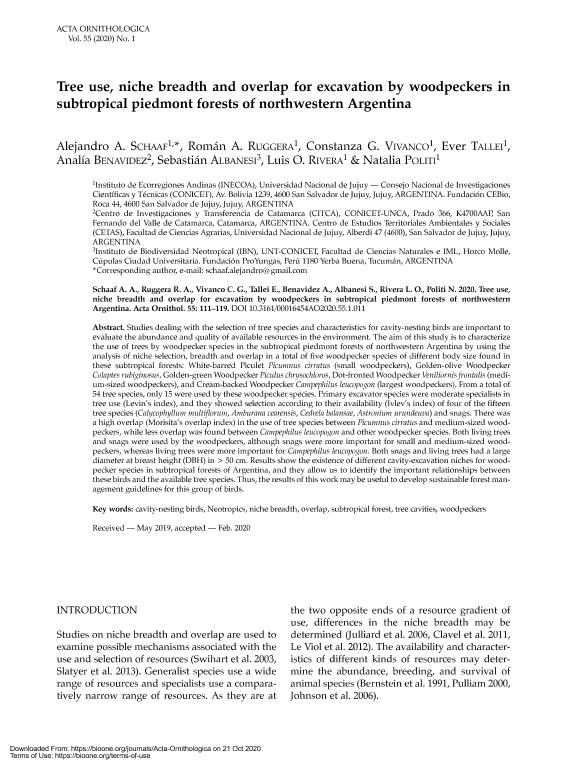Artículo
Tree use, niche breadth and overlap for excavation by woodpeckers in subtropical piedmont forests of northwestern Argentina
Schaaf, Alejandro Alberto ; Ruggera, Román Alberto
; Ruggera, Román Alberto ; Vivanco, Constanza Guadalupe
; Vivanco, Constanza Guadalupe ; Tallei, Ever Denis
; Tallei, Ever Denis ; Benavídez, Analía
; Benavídez, Analía ; Albanesi, Sebastián; Rivera, Luis Osvaldo
; Albanesi, Sebastián; Rivera, Luis Osvaldo ; Politi, Natalia
; Politi, Natalia
 ; Ruggera, Román Alberto
; Ruggera, Román Alberto ; Vivanco, Constanza Guadalupe
; Vivanco, Constanza Guadalupe ; Tallei, Ever Denis
; Tallei, Ever Denis ; Benavídez, Analía
; Benavídez, Analía ; Albanesi, Sebastián; Rivera, Luis Osvaldo
; Albanesi, Sebastián; Rivera, Luis Osvaldo ; Politi, Natalia
; Politi, Natalia
Fecha de publicación:
19/10/2020
Editorial:
Polish Academy of Sciences. Museum and Institute of Zoology
Revista:
Acta Ornithologica
ISSN:
0001-6454
Idioma:
Inglés
Tipo de recurso:
Artículo publicado
Clasificación temática:
Resumen
Studies dealing with the selection of tree species and characteristics for cavity-nesting birds are important to evaluate the abundance and quality of available resources in the environment. The aim of this study is to characterize the use of trees by woodpecker species in the subtropical piedmont forests of northwestern Argentina by using the analysis of niche selection, breadth and overlap in a total of five woodpecker species of different body size found in these subtropical forests: White-barred Piculet Picumnus cirratus (small woodpeckers), Golden-olive Woodpecker Colaptes rubiginosus, Golden-green Woodpecker Piculus chrysochloros, Dot-fronted Woodpecker Veniliornis frontalis (medium- sized woodpeckers), and Cream-backed Woodpecker Campephilus leucopogon (largest woodpeckers). From a total of 54 tree species, only 15 were used by these woodpecker species. Primary excavator species were moderate specialists in tree use (Levin's index), and they showed selection according to their availability (Ivlev's index) of four of the fifteen tree species (Calycophyllum multiflorum, Amburana cearensis, Cedrela balansae, Astronium urundeuva) and snags. There was a high overlap (Morisita's overlap index) in the use of tree species between Picumnus cirratus and medium-sized woodpeckers, while less overlap was found between Campephilus leucopogon and other woodpecker species. Both living trees and snags were used by the woodpeckers, although snags were more important for small and medium-sized woodpeckers, whereas living trees were more important for Campephilus leucopogon. Both snags and living trees had a large diameter at breast height (DBH) in > 50 cm. Results show the existence of different cavity-excavation niches for woodpecker species in subtropical forests of Argentina, and they allow us to identify the important relationships between these birds and the available tree species. Thus, the results of this work may be useful to develop sustainable forest management guidelines for this group of birds.
Archivos asociados
Licencia
Identificadores
Colecciones
Articulos(INECOA)
Articulos de INSTITUTO DE ECORREGIONES ANDINAS
Articulos de INSTITUTO DE ECORREGIONES ANDINAS
Citación
Schaaf, Alejandro Alberto; Ruggera, Román Alberto; Vivanco, Constanza Guadalupe; Tallei, Ever Denis; Benavídez, Analía; et al.; Tree use, niche breadth and overlap for excavation by woodpeckers in subtropical piedmont forests of northwestern Argentina; Polish Academy of Sciences. Museum and Institute of Zoology; Acta Ornithologica; 55; 1; 19-10-2020; 111-119
Compartir
Altmétricas



